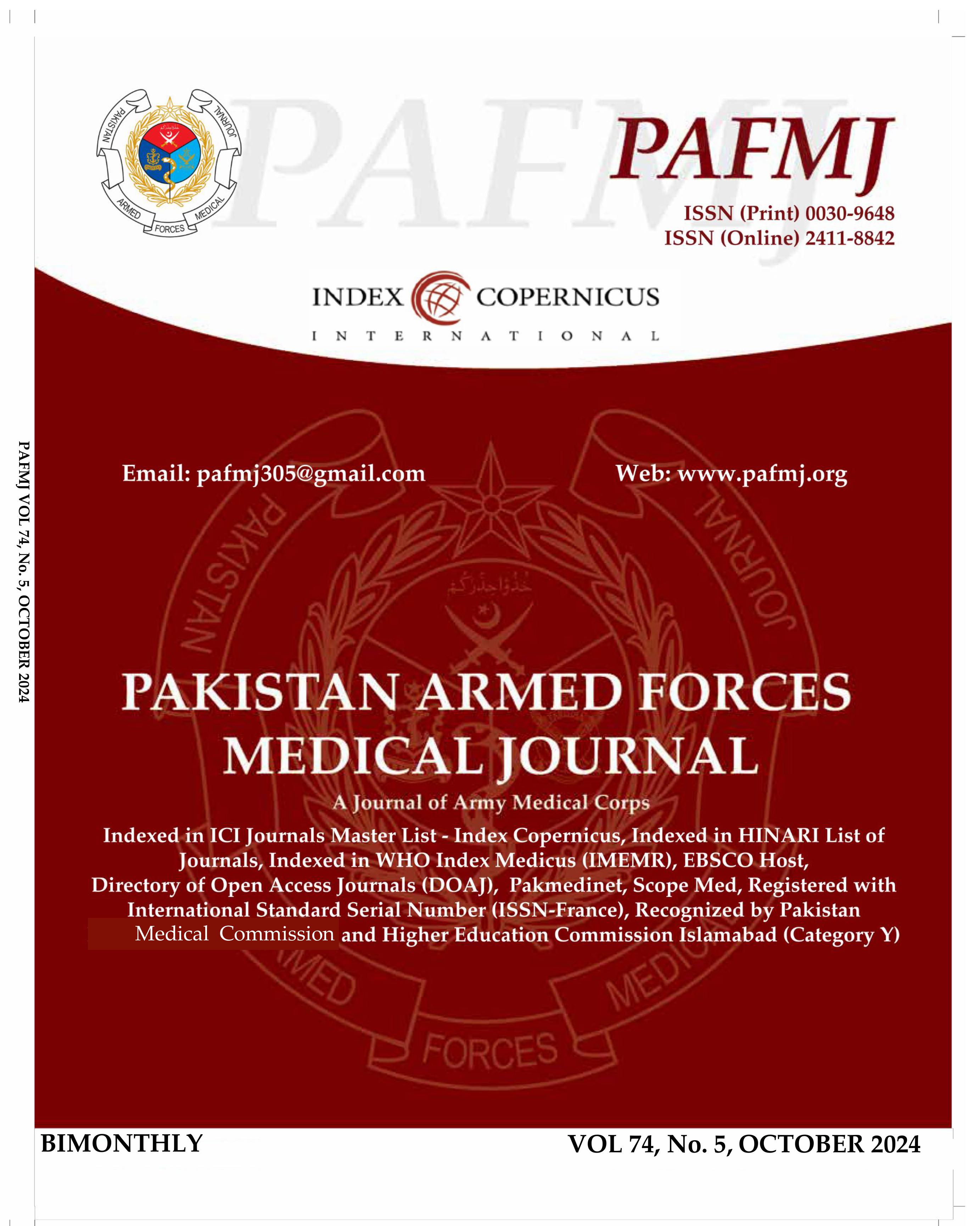Effect of Long-term Azithromycin in Reducing Acute Exacerbation of Chronic Obstructive Pulmonary Disease
DOI:
https://doi.org/10.51253/pafmj.v74i5.6758Keywords:
Azithromycin, Acute exacerbation, Chronic Obstructive Pulmonary Disease.Abstract
Objective: To determine the effect of long-term Azithromycin administration in reducing acute exacerbation of Chronic Obstructive Pulmonary Diseases.
Study Design: Quasi-experimental study.
Place and Duration of Study: Medicine and Pulmonology Departments of Combined Military Hospital, Peshawar Pakistan, from Jun 2019 to May 2020.
Methodology: Patients of Chronic Obstructive Pulmonary Diseases who had more than three hospital admissions in the last one year or required parenteral steroids for management were included in the study. They were randomly divided into two groups where Group-I was administered Azithromycin 500mg, thrice weekly, in addition to routine Chronic Obstructive Pulmonary Diseases medications, and Group-2 received only routine Chronic Obstructive Pulmonary Diseases medications. Both groups were compared for hospital admission due to Chronic Obstructive Pulmonary Diseases, hospital admission due to other causes, parenteral steroid use and Emergency Department visits after six months.
Results: Out of 150 patients of Chronic Obstructive Pulmonary Diseases, 78(52%) received Azithromycin for six months while 72(48%) received only usual treatment of Chronic Obstructive Pulmonary Diseases, while 13(16.6%) patients from Azithromycin-Group had more than three Chronic Obstructive Pulmonary Disease related hospital admissions in six months. However, 34(47.2%) patients in non-Azithromycin-Group had more than three such admissions. More than three Chronic Obstructive Pulmonary Disease related hospital admissions and use of parenteral steroids were found significantly more in non-Azithromycin-Group (p-value <0.001).
Conclusion: Long-term Azithromycin use was found beneficial for patients suffering from Chronic Obstructive Pulmonary Diseases. Use of parenteral steroids and Chronic Obstructive Pulmonary.....
Downloads
References
Collins JA, Rudenski A, Gibson J, Howard L, O'Driscoll R. Relating oxygen partial pressure, saturation and content: the haemoglobin–oxygen dissociation curve. Breathe 2015; 11(3): 194-201. https://doi.org/10.1183/20734735.001415
Sutradhar I, Das Gupta R, Hasan M, Wazib A, Sarker M. Pre-valence and risk factors of chronic obstructive pulmonary disease in Bangladesh: a systematic review. Cureus 2019; 11(1): e3970.
https://doi.org/10.7759/cureus.3970
Oussedik F, Khelafi R, Skander F. The impact of acute exacerbations of COPD on mortality. Rev Mal Respir 2019; 36(1): 7-14. https://doi.org/10.1016/j.rmr.2017.12.005
Cappa V, Marcon A, Di Gennaro G, Chamitava L. Health-related quality of life varies in different respiratory disorders: a multi-case control population-based study. BMC Pulm Med 2019; 19(1): 32.
https://doi.org/10.1186/s12890-019-0796-8
Lief L, McSparron J. Acute exacerbation of COPD. Evidence-Based Critical Care 2019; 169-173.
https://doi.org/10.1007/978-3-030-26710-0_22
Bollmeier SG, Hartmann AP. Management of chronic obstructive pulmonary disease: a review focusing on exacerbations. Am J Health Syst Pharm 2020; 77(4): 259-268.
https://doi.org/10.1093/ajhp/zxz306
Shteinberg M, Schneer S, Lavon O, Adir Y. Long-term treatment with macrolides in chronic lung diseases. Harefuah 2016; 155(9): 567-571.
Naderi N, Assayag D, Mostafavi-Pour-Manshadi SM, Kaddaha Z, Joubert A, Ouellet I, et al. Long-term Azithromycin therapy to reduce acute exacerbations in patients with severe chronic obstructive pulmonary disease. Respir Med 2018; 138(3): 129-136.
https://doi.org/10.1016/j.rmed.2018.03.035
Herath SC, Normansell R, Maisey S, Poole P. Prophylactic antibiotic therapy for chronic obstructive pulmonary disease (COPD). Cochrane Database Syst Rev 2018; 10(10): CD009764.
https://doi.org/10.1002/14651858.CD009764.pub3
Sultana T, Afzal A, Sultana S, AlGhanim K, Shahid T, Jabeen Z, et al. Epidemiological estimates of respiratory diseases in the hospital population, Faisalabad, Pakistan. Braz Arch Biol Technol 2017; 60(1): e17160358.
Cao Y, Xuan S, Wu Y, Yao X. Effects of long-term macrolide therapy at low doses in stable COPD. Int J Chron Obstruct Pulmon Dis 2019; 14(3): 1289-1298.
https://doi.org/10.2147/COPD.S205075
Pinto LM, Gupta N, Tan W, Li PZ, Benedetti A. Derivation of normative data for the COPD assessment test (CAT). Respir Res 2014; 15(1): 68. https://doi.org/10.1186/1465-9921-15-68
Taylor SP, Sellers E, Taylor BT. Azithromycin for the prevention of COPD exacerbations: the good, bad, and ugly. Am J Med 2015; 128(12): 1362.e1-6.
https://doi.org/10.1016/j.amjmed.2015.07.032
Yawn BP, Mintz ML, Doherty DE. GOLD in practice: chronic obstructive pulmonary disease treatment and management in the primary care setting. Int J Chron Obstruct Pulmon Dis 2021; 16(3): 289-299.
https://doi.org/10.2147/COPD.S222664
Threapleton CJ, Janjua S, Fortescue R, Baker EH. Head-to-head oral prophylactic antibiotic therapy for chronic obstructive pulmonary disease. Cochrane Database Syst Rev 2019; 5(5): CD013024.
https://doi.org/10.1002/14651858.CD013024.pub2
Pomares X, Montón C, Bullich M, Cuevas O, Oliva JC, Gallego M, et al. Clinical and safety outcomes of long-term Azithromycin therapy in severe COPD beyond the first year of treatment. Chest 2018; 153(5): 1125-1133.
https://doi.org/10.1016/j.chest.2018.01.044
Choi Y, Shin SH, Lee H, Cho HK, Im Y, Kang N, et al. Favorable response to long-term Azithromycin therapy in bronchiectasis patients with chronic airflow obstruction compared to chronic obstructive pulmonary disease patients without bronchiectasis. Int J Chron Obstruct Pulmon Dis 2021; 16(3): 855-863.
https://doi.org/10.2147/COPD.S292297
Albert RK, Connett J, Bailey WC, Casaburi R, Cooper JA Jr, Criner GJ, et al. Azithromycin for prevention of exacerbations of COPD. N Engl J Med 2011; 365(8): 689-698.
Downloads
Published
Issue
Section
License
Copyright (c) 2024 Husnain Saleem, Muhammad Amir, Syed Anees Ahmed Gardezi, Mumtaz Amir, Zulqarnain, Hasan Saleem

This work is licensed under a Creative Commons Attribution-NonCommercial 4.0 International License.















